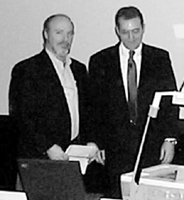A Conversation with SIAM's Vice President for Industry
December 1, 2003

Kirk Jordan of IBM (left) with David Klepacki of the IBM T.J. Watson Research Center, at the SIAM Conference on Mathematics for Industry, Toronto, October 13-15. As SIAM's vice president for industry, Jordan worked with members of the SIAM Great Lakes Section and others to organize the conference.
By several measures, then SIAM president Tom Manteuffel chose wisely in 2000 when he appointed Kirk Jordan SIAM vice president for industry. Most obviously, Jordan has spent most of his career working in industry---first in petroleum (Exxon, 1981-1989) and then in the computer industry (Thinking Machines, Kendall Square, and, for the last nine years, IBM). He's also had a taste of academia: As a graduate student (University of Delaware, where he was, he says, the first student in the department to do a thesis that was heavily numerical), he fully intended to become a professor of mathematics; he pursued that plan from 1979 to 1981, as a member of the faculty at SUNY Oswego, and is now officially a research affiliate at MIT. Perhaps best of all, he has managed at IBM to combine the best of both worlds.
Asked during an August visit to SIAM about his current position at IBM, he searches his pockets for a business card. The hesitation is immediately understandable when he reads off his title, "Emerging Solutions Executive, Life Sciences."
What that means was indirectly the subject of a talk Jordan gave in Sydney, as part of an industrial minisymposium at ICIAM 03. About a year ago, he explained, IBM had sent him out in the world to learn "what systems biology is and what IBM should be doing about it." In the talk, he considered the big themes in systems biology---automated analysis, the building of descriptive models, and of predictive dynamic models from simulations---along with a spectrum of modeling tools, a description of the various levels of abstraction at which people work, and some examples, including a mechanistic model of the actin cycle.
Mathematical skills of all sorts are needed for the problems that arise in systems biology, he said: On the theoretical side, biogeometry is a rich area; from an applied perspective, modeling, simulation, and PDE methods all play important roles, as do techniques in discrete mathematics. Anyone wishing to work on these problems, he emphasized, needs to learn the language of biology- "there are lots of problems to work on if we do."
Jordan himself works on many of those problems, with people, mainly academics, all over the world. The responsibilities of his cryptically named position at IBM include building ties with academia, industry, and national laboratories. The point, of course, is to sell IBM hardware, software, and accompanying services to customers doing research in the life sciences. What makes it appealing for him is that he needs to be working with good people so that he can understand their computing requirements and feed them back to IBM.
As he works to link application end-users with IBM computer architects, he "begs, borrows, and steals students and research associates," always hoping to "plant seeds for good research." Sometimes he works on the projects himself; often---as in the case of a tumor growth project with a group at Massachusetts General Hospital and a Bayesian network project with researchers in MIT's Computational and Systems Biology Initiative---his main contributions consist of bringing research groups together and developing the "infrastructure needed to get the projects really rolling." His visit to SIAM was scheduled to coincide with a visit to the University of Pennsylvania; having connected groups at IBM and Penn, and encouraged them to develop the National Digital Mammography Archive project, he was meeting with some of the researchers to discuss additional projects.
He offers a concise statement of the theme of his work: "How can I do good science to improve the bottom line?"
In the course of his SIAM visit, Jordan also described a very different theme that has been a crucial factor in his career: skiing. Well beyond the level of the enthusiast who heads for the expert trails on every possible winter weekend, Jordan has been working his way through the levels of the Professional Ski Instructors Association of America. He passed level 1 in 1980, and the second half of level 3 (the highest), last January, making him a fully certified Professional Ski Instructor. Come December 1 each year, his week at IBM ends on Friday at 3:00. All winter, Friday afternoons and weekends are devoted to skiing and teaching skiing (and running ski programs for 4- to 6-year olds).

A regular participant in the annual Copper Mountain Conferences, SIAM vice president for industry Kirk Jordan skis with some of his research collaborators and at the same time keeps up with his other career: A certified Professional Ski Instructor, he spends winter weekends skiing and teaching children to ski.
Every decision on his career path has been related to skiing, he says, beginning with the decision not to major in chemistry (too many labs) in favor of math (and the greater flexibility it offers) and to do his graduate work at Delaware (far enough south that he wouldn't constantly be off skiing, but not so far that he couldn't work in an occasional day ski trip). He's been less hard on himself geographically in accepting jobs, but he's made the weekend arrangement clear to each of his employers and has always found it to work.
Given his passion for both skiing and high-performance computing (and applied mathematics), why did he agree to become SIAM's vice president for industry? Clearly intense about the things he takes on, he might have been expected to turn Tom Manteuffel down. "I feel a kinship to SIAM," he says, dating back to graduate school. He belongs to several organizations, but "SIAM is the one society I really participate in---the one place where the math comes into play with the problems."
Manteuffel has a much simpler explanation: "He would have had a hard time turning me down," he says; "we ski together during the Copper Mountain Conferences in April each year, and we were on the lift when I asked him to take the position."
One of Jordan's goals as vice president for industry is to make people working in industry more aware of what SIAM offers them. A current priority (it's still November as this issue of SIAM News goes to press) is the organization of a panel on career opportunities for the 2004 annual meeting in Portland, Oregon. "There are lots of jobs out there---it's knowing how to look for them," he says. Jordan helped organize such panels for the SIAM meetings in San Diego and Philadelphia; he reports good feedback on both, with standing room only for the session in Philadelphia.
Further in the future, he looks forward to helping with the organization of the next SIAM conference on mathematics in industry, which is likely to follow the successful Toronto meeting, and encourages readers to contact him with suggestions.
More broadly, Jordan says, "I am interested in any ideas that would lead to more industry participation in SIAM" and that would "encourage SIAM to be more relevant to the industry membership." As SIAM's vice president for industry, he concludes, "I really want to make the "I" in SIAM a strong piece of the society." The hope is that "people in industry who have a mathematical background will want to be members, which will make SIAM a society more such individuals will want to join and participate in. In this way, I believe all members of SIAM will benefit."

